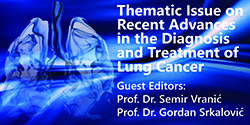An Update on Molecular Genetic Aberrations in Spitz Melanocytic Proliferations: Correlation with Morphological Features and Biological Behavior
DOI:
https://doi.org/10.5644/ama2006-124.333Keywords:
Spitz Melanocytic Proliferations, Kinase Fusions, 11p Amplification/HRAS Mutation, Morphology, Clinical BehaviorAbstract
The aim of the paper is to give an update on molecular genetic aberrations in Spitz melanocytic proliferations with special em- phasis on their correlation with morphological features and biological behavior. The Spitz group of melanocytic proliferations is defined by a combination of distinctive morphological features and driver molecular genetic events. Morphologically, these neoplasms are characterized by large, oval, polygonal, or spindled melanocytes with abundant eosinophilic cytoplasm, vesicular nuclei with prominent nucleoli, often in association with epidermal hyperplasia. Molecular aberrations in Spitz melanocytic proliferations can be divided into two main groups, according to the driver genetic change: 1) 11p amplification/HRAS muta- tion, present in about 20% of cases, and 2) kinase fusions, present in about 50%, further subdivided into tyrosine kinase fusions (ALK, ROS1, NTRK1, NTRK3, MET, RET) or serine-threonine kinase fusions (MAP3K8, BRAF). Driver genetic aberrations can be detected along the whole biological spectrum of Spitz melanocytic proliferations, and are mutually exclusive. Although driver genetic aberrations enable proliferation of melanocytes, additional genetic events (often biallelic inactivation of CDKN2A and TERT promoter mutations) are necessary for the development of overt Spitz malignancy.
Conclusions. Recent studies have demonstrated that certain driver genetic aberrations are more often associated with the benign spectrum of Spitz melanocytic proliferations and indolent biological behavior (11p amplification/HRAS mutation, tyrosine kinase fusions). In contrast, some driver aberrations are more frequent in the atypical/malignant spectrum of Spitz melanocytic proliferations with a potential for aggressive biological behavior (serine-threonine kinase fusions). In addition, certain driver aberrations are often associated with distinctive morphological features. However, none of the morphological features is entirely specific for any of these driver genetic aberrations. Immunohistochemistry for ALK, ROS1, and pan-TRK can be used for screening purposes to detect cor- responding fusion proteins.
Downloads
Published
Issue
Section
License
Copyright (c) 2021 Daja Šekoranja, Jože Pižem, Boštjan Luzar

This work is licensed under a Creative Commons Attribution-NonCommercial 4.0 International License.






